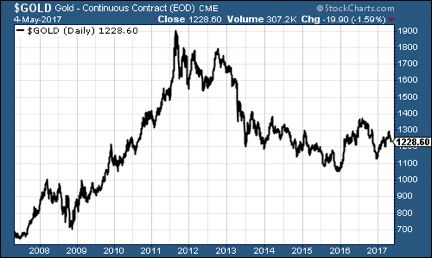
There have been some interesting moves in our six “charts that matter” this week.
Gold
Gold has had a nightmare week. Last week when I wrote to you, it was trading at around $1,265. Now, as the chart shows, it’s crashed to below $1,230.
Practically everything has been stacked against gold this week. Firstly, the US Federal Reserve was a tad more bullish in its assessment of the US economy than anyone had expected at its meeting on Wednesday, which caused markets to revise up their expectations for the pace of rate rises, which is never great for gold.
Secondly, markets are fairly relaxed about the French election this weekend. It might still go Marine Le Pen’s way, but that does seem unlikely. Again, a calming of geopolitical nerves has made investors less inclined to own gold.
Finally, the commodities sector in general has been having a tough time, as we’ll get to in just a moment. This isn’t always bad news for gold – but on this occasion, gold has followed the rest of its industrial compatriots lower.
Copper
Last week it was priced at $2.59 per pound. Now it’s down to $2.51, quite a slump.
The big concern for commodities (and gold to a lesser extent) is China. As I wrote in Money Morning earlier this week, investors are starting to fret about a crackdown on borrowing in China and a resulting slowdown in growth.
When China reins in monetary creation, it’s always bad news for the commodities sector. Whether or not this spreads to other parts of the asset markets is another question. With oil falling hard as well, markets might be inclined to look on the bright side and see it as good for consumers and for corporate profits (as costs are lower).
US dollar
In the face of the commodities rout you would normally expect a sharply higher dollar, but the US dollar is in fact little changed this week. It was at 98.96 when I wrote last Friday and now it’s at 98.65.
This is another chart that points to the real concern being China right now. Normally when I see gold slide, I usually look to the dollar to rise strongly – and clearly that’s not been the case this week.
Depending on the French election result, the dollar index could fall further – the euro makes up a large chunk of the index, so if it strengthens after an Emmanuel Macron victory, then the dollar could weaken.
US Treasuries
In a similar vein, there’s ten-year US Treasury bonds. Yields are continuing to pick up a little, rising from 2.3% last time, to 2.36% now. This is partly down to expectations for a Fed rate rise being brought forward by investors,
Bitcoin
The cryptocurrency has had a cracking week, really rubbing salt in gold’s wounds. A single bitcoin will now buy you an ounce of gold with enough change left over to treat yourself and a partner to a slap-up meal with a good bottle of wine to celebrate your investing nous.
I told you last week that Charlie Morris, my colleague and editor of The Fleet Street Letter, had put a $1,700 target on bitcoin. Well, we’re already nearly there, as you can see:
Source: bitcoincharts.com
This is quite unusual. Bitcoin often moves similarly to gold. It also reacts badly when China seems to be in trouble (although of course, some of this week’s gains could be driven by people trying to get their money out of China). So why hasn’t bitcoin fallen out of bed this week with everything else?
It’s partly because of huge demand from Japan. The Japanese recently deemed bitcoin a legal means of payment and investors and speculators are lapping it up.
And when you look at that chart above, you have to think that bitcoin is moving into its parabolic phase now (or another one at least). Is it a bubble? That word is overused, and in any case, I don’t think it is. But as bitcoin hogs more and more headlines, and draws more and more new money, we could see a mania developing that takes the price well beyond where it is today.
Again, it’s all speculative. But it’s interesting stuff.
US jobless claims
To recap, David Rosenberg of Gluskin Sheff sees this is a valuable leading indicator. When the figure hits a “cyclical trough” (as measured by the four-week moving average), a stockmarket peak is not far behind, and a recession follows about a year later.
As the short-term chart above shows, it looked as though jobless claims troughed at just under 240,000 at the end of February. So we’d be looking at the market (the S&P 500) peaking around the end of May.
However, this week jobless claims fell sharply to 238,000. Another few runs like this, and we might find that the indicator hits a new trough – and maybe we’re safe from recession for another few months.